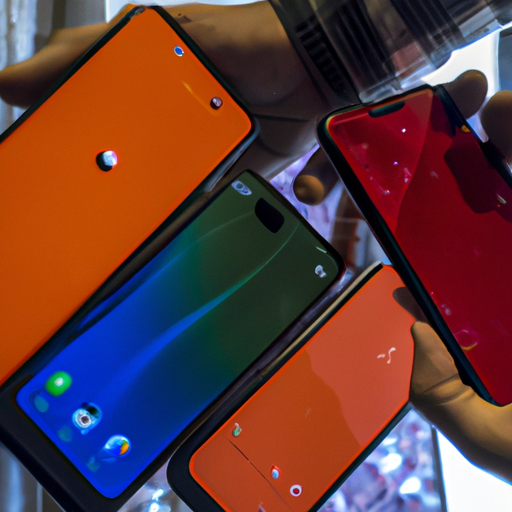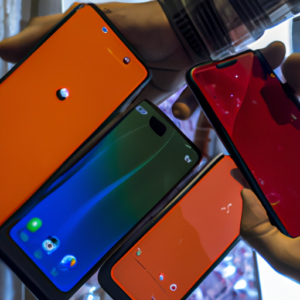In this article, we will explore the factors to consider when selecting a smartphone that best fits your needs. We’ll discuss the importance of operating systems, screen size, camera quality, battery life, and storage capacity. By the end, you’ll have a better understanding of what features to prioritize and be equipped to make an informed decision when purchasing your next smartphone. So, let’s get started on finding the perfect smartphone for you! With so many options available in the market, it can be overwhelming to choose the right smartphone for your needs. Whether you are a tech-savvy individual or someone who just wants a reliable device, there are several factors that you should consider before making a purchase. In this article, we will discuss the various factors that can help you make an informed decision.

Budget
One of the first factors to consider when choosing a smartphone is your budget. It is important to determine the maximum amount you are willing to spend on a smartphone. By setting a budget, you can narrow down your options and focus on devices that fall within your price range.
Determining your budget
To determine your budget, consider your financial situation and how much you are willing to invest in a smartphone. Think about the features you need and whether you are willing to spend extra for premium options.
Finding smartphones within your budget
Once you have determined your budget, it is time to research and find smartphones that fit within that range. There are various websites and online platforms that allow you to compare prices and features of different devices. Take your time to explore these options and make a list of smartphones that meet your budget criteria.
Comparing prices and features
When comparing prices and features, make sure to consider both the upfront cost and any additional expenses such as monthly service charges or optional accessories. Look for smartphones that offer good value for money and have the features you need.
Operating System
The operating system of a smartphone plays a crucial role in its performance and user experience. There are primarily three major operating systems to choose from: Android, iOS, and Windows.
Understanding different operating systems
Android, developed by Google, is the most widely used operating system in the market. It offers a high level of customization and compatibility with a wide range of apps. iOS, developed by Apple, is known for its seamless integration with Apple products and its privacy features. Windows, on the other hand, offers a unique user interface and is popular among those who prefer a familiar desktop-like experience.
Factors to consider when choosing an operating system
When choosing an operating system, consider factors such as app availability, user interface, and security features. Take into account your past experience with different operating systems and choose one that aligns with your preferences.
Processor
The processor is the heart of a smartphone, responsible for its speed and performance. There are different types of processors available in the market, each with its own strengths and weaknesses.
Different types of processors
The most common types of processors found in smartphones are Qualcomm Snapdragon, Apple A-Series, and MediaTek. Qualcomm Snapdragon processors are known for their high performance and power efficiency. Apple A-Series processors are designed specifically for iPhones and are highly optimized for Apple’s iOS. MediaTek processors, on the other hand, offer a budget-friendly option without compromising on performance.
Importance of processor speed and performance
The processor speed, measured in GHz, determines how fast your smartphone can perform tasks and run apps. A faster processor can handle multitasking and resource-intensive apps more efficiently.
Balancing power consumption and efficiency
While a faster processor offers better performance, it often consumes more power. It is important to find a balance between performance and power consumption based on your usage patterns and priorities.

RAM and Storage
RAM and storage capacity are important factors to consider when choosing a smartphone. RAM, or Random Access Memory, determines the device’s ability to handle multiple tasks simultaneously, while storage capacity determines the amount of data you can store on your smartphone.
Importance of RAM and storage capacity
Having sufficient RAM allows your smartphone to run smoothly and handle multitasking efficiently. More RAM enables faster app loading times and smoother user experience. On the other hand, storage capacity determines how many apps, photos, videos, and files you can store on your device.
Determining your needs
To determine the right amount of RAM and storage capacity, consider your usage patterns and requirements. If you are someone who uses multiple apps simultaneously or plays graphic-intensive games, opting for a smartphone with higher RAM capacity is recommended. Similarly, if you frequently store large files, such as photos and videos, choosing a device with higher storage capacity is advisable.
Choosing the right balance
It is important to strike the right balance between RAM and storage capacity based on your needs and budget. Opting for a smartphone with excessive RAM and storage capacity may unnecessarily increase the cost of your device.
Camera
The camera has become an integral part of smartphones, allowing users to capture high-quality photos and videos on the go. When choosing a smartphone, it is important to consider the camera specifications and features.
Types of smartphone cameras
There are primarily two types of smartphone cameras – rear-facing and front-facing. Rear-facing cameras are usually higher in resolution and offer better image quality, while front-facing cameras are designed for selfies and video calls.
Considering megapixels and image quality
Megapixels determine the resolution of the photos captured by the camera. However, it is important to note that a higher number of megapixels does not necessarily mean better image quality. Factors such as the camera sensor, image stabilization, and processing software also contribute to the overall image quality.
Additional camera features and modes
Smartphones nowadays come with a range of additional camera features and modes, such as portrait mode, night mode, and wide-angle lens. Consider the camera features that are important to you and choose a smartphone that offers them.
Battery Life
Battery life is a crucial factor to consider when choosing a smartphone, especially if you are someone who is constantly on the go and relies heavily on your device.
Understanding battery capacity and usage
Battery capacity is measured in milliampere-hour (mAh), which indicates how much charge a battery can hold. The higher the mAh rating, the longer the battery will last. However, battery life also depends on factors such as screen brightness, app usage, and connectivity options.
Factors influencing battery life
Several factors influence battery life, including the type of processor, display technology, and software optimization. Consider these factors and choose a smartphone that offers good battery performance.
Comparing battery performance
When comparing battery performance, consider real-world usage scenarios and user reviews. Look for smartphones that offer longer battery life and also support fast charging technologies.
Screen Size
Screen size is a personal preference and depends on the purpose of use, whether it is for watching videos, playing games, or simply browsing the web.
Evaluating screen size and resolution
Smartphones come in various screen sizes, ranging from compact models with screen sizes below 6 inches to larger models with screen sizes above 6 inches. Consider the activities you primarily use your smartphone for and choose a screen size that aligns with your preferences.
Considering display technologies
There are different display technologies used in smartphones, such as LCD, OLED, and AMOLED. Each technology offers its own advantages and disadvantages in terms of color reproduction, contrast ratio, and power consumption. Research the pros and cons of different display technologies and choose one that suits your needs.
Ergonomics and personal preferences
Apart from screen size and display technology, ergonomics and user experience should also be considered. Factors such as bezel size, weight, and form factor contribute to the overall comfort and convenience of using the device. Visit a physical store if possible and hold the smartphone in your hand to assess its ergonomics.
Design and Durability
The design and durability of a smartphone are important considerations, as they determine how the device looks and how well it can withstand daily wear and tear.
Aesthetics and ergonomic factors
The design of a smartphone includes elements such as the materials used, the placement of buttons and ports, and the overall aesthetics. Consider your personal preferences and choose a design that appeals to you.
Build materials and durability considerations
Smartphones are made using various materials, such as glass, metal, and plastic. Each material has its own advantages and disadvantages in terms of durability and aesthetics. Consider factors such as scratch resistance, impact resistance, and overall build quality when choosing a smartphone.
Water and dust resistance
Water and dust resistance is an important feature to consider, especially if you frequently use your smartphone in environments where it may be exposed to moisture or dust. Look for smartphones that offer some level of water and dust resistance, such as an IP rating.
Connectivity
Smartphones offer various connectivity options, such as Wi-Fi, Bluetooth, NFC, and cellular connectivity. Consider your connectivity needs and assess whether the smartphone offers the necessary options.
Wi-Fi, Bluetooth, and NFC
Wi-Fi allows you to connect to the internet wirelessly, while Bluetooth enables you to connect to other devices, such as headphones or speakers, wirelessly. NFC (Near Field Communication) allows for convenient contactless transactions and data transfer between compatible devices.
Cellular connectivity
Cellular connectivity allows you to make calls and access the internet through your cellular network. It is important to ensure that the smartphone you choose is compatible with your carrier’s network bands.
Additional Features
Apart from the above factors, there are several additional features that you may consider when choosing a smartphone. These can include fingerprint sensors, face recognition technology, expandable storage options, and wireless charging capabilities. Assess your needs and preferences and choose a smartphone that offers the features that are important to you.
Conclusion
Choosing the right smartphone for your needs requires careful consideration of various factors. By determining your budget, understanding different operating systems, considering the processor, RAM, and storage capacity, assessing the camera specifications and battery life, evaluating screen size and design, and considering connectivity options and additional features, you can make an informed decision. Remember to prioritize your needs and preferences while keeping in mind the price-to-value ratio. With so many options available, choosing the right smartphone may take time, but it is essential for a device that meets your requirements and enhances your mobile experience.
